search engine by freefind |
advanced |
|
There are numerous stories about the Tower passed down through American Indian culture. Although popular culture would label them myths or legends, a more appropriate term would be oral histories, or in many cases sacred narratives. These stories helped to connect people with the Tower site. Sacred narratives are told today with a reverence to the beliefs and people of the past. Each tribe had their own oral history, and in many cases multiple histories exist from the same tribe. Many of the stories contain similar elements. They are preserved today by the the traditions of American Indian culture and the work of historians passed. Although the following stories are products of the past, the tribes they are associated with are active members of our present. They each have sovereign nations within the United States (known as reservations). The people and members of those tribes are a part of our modern national community, and their connections with places like the Tower are as important today as they were for generations before this sacred place became a national monument. 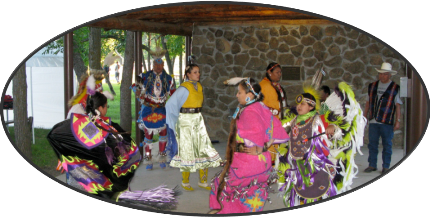
NPS Arapahoe An Arapahoe lodge was camped at Bear's Tipi. The father of this lodge was a head lodge and had seven children, five boys and two girls. The two girls had made an arrangement between themselves that the one who found the end rib-bone of a bison should receive the most favors from the brothers. The boys often made trips to other tribes. After a long search one of the girls found an end bone of a bison, but on picking it up she turned into a bear and made some big scratches on her sister's back. The 'bear-girl' told her sister, "If you tell, the dogs will howl and this will be a signal so I will know that you have told." The sister did tell her brothers and when they heard the dogs howl and give the signal they were scared and started to run. The bear-girl heard the signal and ran after them. The girl who had told was carrying a ball in her hand which she dropped and accidentally kicked. The ball bounded up on the big, high rock. The bear-girl reached over her sister's shoulder to grab the ball, slipped and made very big scratches on the big rock and fell on her sister and broke the sister's chest. The bear-girl climbed to the top of the big, high rock and told her family that there would be seven stars in the shape of a diamond appear in the east; she said the first star out would be off to one side and would be brighter than the other stars. The first star would be called "Broken Chest Star." From this time on, the Arapahoes called this big, high rock "Bear's Tipi." This story was told by Sherman Sage, who learned it from his father, Straight-Old-Man (who in turned learned it from his father, Drying-Up-Hide). It was recorded on August 19, 1932. 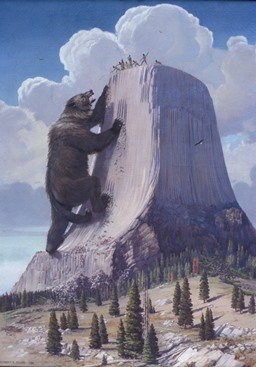
NPS / Herbert Collins Cheyenne A band of Cheyennes went on one of their visits to Na Kovehe (Bear Lodge) to worship the great spirit, as did many other tribes. Families and all members of the tribe came, as Bear Lodge was known as a holy place. After having camped there for several days one of the Cheyenne braves noticed that his wife was gone from camp, staying away for a short time. As time went on, he noticed that she was gone longer than before. This brave could not understand why his wife should be gone from their lodge so much as he had always been devoted to her, being a good hunter as well as a brave warrior. She always had much buffalo, antelope and deer meat. He furnished her fine skins to make nice clothes. Becoming suspicious that some other brave in his band might be courting his wife, he watched to see what man was missing when his wife left camp. He found that no man was missing when his wife was gone. This man also saw that his wife had a skin over her shoulders, which she did not wear before coming to this camp. One day when she had been gone longer than usual, he laid in wait for her. On her return her asked her where she had been and what drew her from camp so much of the time. She would not answer any of his questions. Then the man became mad and tore the skin from her shoulders and saw that she was covered with scratches. He demanded that she tell him which man had abused her. Becoming frightened at the way her husband was acting, she told him that she had been charmed by a very big bear that lived in the big rock. The bear had no mate and had become infatuated with her while she was out gathering fruit. Fearing for the safety of the camp, she had submitted to the bear's embraces, which accounted for the scratches on her shoulders. Then the warrior told his wife to lead him to the bear so he could kill it. When they found the bear the man had great fear because the bear was big, very big. The bear slapped the woman with his paw and changed her into a bear. The man ran to the camp to get the rest of the braves to help him kill the big bear. They found the bear had crawled into a cave, leaving his hind feet in the door. The bear's feet were so big that nobody could get past them. They could not get close enough to the bear to kill him so they shot at his feet to make him come out. When the bear came out he was so big that all the warriors were scared and climbed up on a big rock. These men were so scared that they prayed to the Great Spirit to save them. In answer to their prayers, the rock began to grow up out of the ground and when it stopped it was very high. The bear jumped at the men and on the fourth jump his claws were on the top. The Great Spirit had helped the men and now they had great courage and they shot the bear and killed him. When the bear fell backwards and pushed the big rock, the big rock leaned. After that the bear-woman made this big rock her home, so the Cheyennes call it "Bear Lodge." This legend was told to Dick Stone by Young-Bird, a Cheyenne, whose home was on the Lame Deer Reservation. Samuel Weasel Bear acted as an interpreter. Young-Bird said, "This is a true story. It happened." 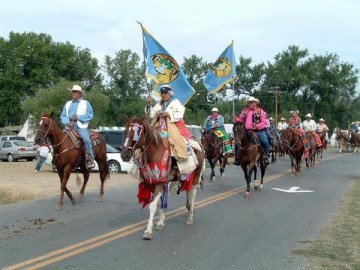
Courtesy of Realbirdium at the English language Wikipedia Crow Once when some Crows were camped at "Bear's House," two little girls were playing around some big rocks there. There were lots of bears living around the big rock, and one big bear, seeing the girls alone, was going to eat them. The big bear was just about to catch the girls when they saw him. The girls were scared and the only place they could get was on top of the rocks around which they had been playing The girls climbed the rock but still the bear could catch them. The Great Spirit, seeing the bear was about to catch the girls, caused the rock to grow up out of the ground. The bear kept trying to jump to the top of the rock but he just scratched the rock and fell down on the ground. The claw marks are on the rock now. The rock kept growing until it was so high that the bear could not get the girls. The two girls are still on top of the rock. This legend was told to Dick Stone by Ride-The-White-Hip-Horse. Interpreted by Goes-To-Magpie. During a celebration in 1932 on the Crow Agency in Montana, Max Big Man was questioned about the Tower. He explained: "The Indians called the Devils Tower "Bear's Tipi" or "Bear Lodge," because so many bears lived there. They believed it was put there by the Great Spirit for a special reason, because it was different from the other rocks, rising high up in the air, instead of being on the ground. For this reason it was looked upon as a holy place, and the Indians went there to worship and fast." 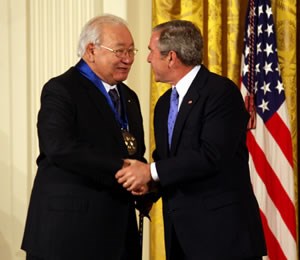
Kiowa Before the Kiowa came south they were camped on a stream in the far north where there were a great many bears, many of them. One day, seven little girls were playing at a distance from the village and were chased by some bears. The girls ran toward the village and the bears were just about to catch them when the girls jumped on a low rock, about three feet high. One of the girls prayed to the rock, "Rock take pity on us, rock save us!" The rock heard them and began to grow upwards, pushing the girls higher and higher. When the bears jumped to reach the girls, they scratched the rock, broke their claws, and fell on the ground. The rock rose higher and higher, the bears still jumped at the girls until they were pushed up into the sky, where they now are, seven little stars in a group (The Pleiades). In the winter, in the middle of the night, the seven stars are right over this high rock. When the people came to look, they found the bears' claws, turned to stone, all around the base. No Kiowa living has ever seen this rock, but the old men have told about it - it is very far north where the Kiowa used to live. It is a single rock with scratched sides, the marks of the bears' claws are there yet, rising straight up, very high. There is no other like it in the whole country, there are no trees on it, only grass on top. The Kiowa call this rock "Tso-aa", a tree rock, possibly because it grew tall like a tree. Told by I-See-Many-Camp-Fire-Places, Kiowa soldier at Fort Sill, Oklahoma, 1897. 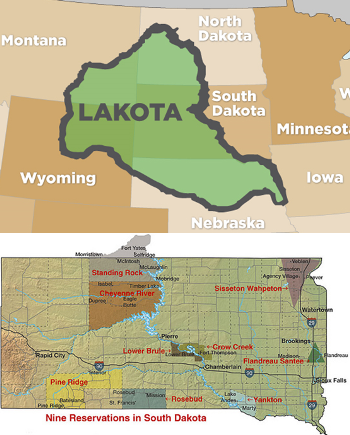
Composite of web-based images Lakota In the Lakota tribe long ago was a brave warrior who often went alone into the wilderness where he would fast and worship the Great Spirit in solitude. Being alone helped him to strengthen his courage so that in the future he could carry out his plans. One day this warrior took his buffalo skull and went along into the wilderness to worship. Standing at the base of Mato Tipila after he had worshipped for two days he suddenly found himself on top of this high rock. He was very much frightened as he did not know how he would get down. After appealing to the Great Spirit he went to sleep. When he awoke he was very glad to find that he was again at the base of this high rock. He saw that he was standing at the door of a big bear's lodge as there was foot prints of a very big bear there. He could tell that the cracks in the big rock were made by the big bear's claws. So he knew that all the time he had been on top of this big rock he had been standing on a big bear's lodge. From this time on his nation called this big high rock Mato Tipila and they went there often to worship. The buffalo skull is still on top of this big high rock and can be seen on the highest point. This legend told to Dick Stone by Short Bull, who lived a short distance west of Oglala, South Dakota, on July 31, 1932. Mark Running Eagle, Interpreter. |

Comments